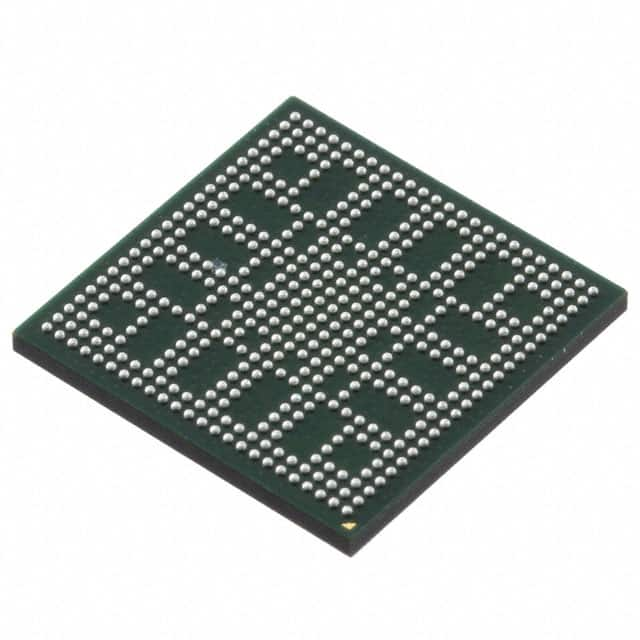Consulte las especificaciones para obtener detalles del producto.

MCIMX6L2DVN10AA
Product Overview
- Category: Integrated Circuit (IC)
- Use: Embedded System
- Characteristics: High-performance, low-power consumption
- Package: 10x10 mm BGA package
- Essence: ARM Cortex-A9 processor
- Packaging/Quantity: Individually packaged, quantity varies based on order
Specifications
- Processor: ARM Cortex-A9
- Clock Speed: Up to 1 GHz
- Operating Voltage: 1.0V - 1.3V
- Operating Temperature: -40°C to +85°C
- Memory: 512 KB L2 cache, external DDR3 support
- Connectivity: Ethernet, USB, UART, SPI, I2C, GPIO
- Graphics: 2D and 3D graphics acceleration
- Power Consumption: Low power consumption for energy-efficient applications
Detailed Pin Configuration
The MCIMX6L2DVN10AA has a total of 289 pins. The pin configuration is as follows:
- Pins 1-20: Power supply and ground pins
- Pins 21-50: Processor control and clock pins
- Pins 51-100: Memory interface pins
- Pins 101-150: Communication interface pins
- Pins 151-200: Graphics and display interface pins
- Pins 201-250: Input/output pins
- Pins 251-289: Reserved pins
Functional Features
- High-performance processing capabilities
- Support for various communication interfaces
- Graphics acceleration for enhanced visual experience
- Low power consumption for energy-efficient applications
- Flexible memory options for efficient data handling
- Wide operating temperature range for versatile usage scenarios
Advantages and Disadvantages
Advantages
- Powerful processing capabilities enable complex tasks
- Versatile connectivity options for seamless integration
- Energy-efficient design for reduced power consumption
- Compact package size for space-constrained applications
- Wide operating temperature range for diverse environments
Disadvantages
- Limited memory capacity compared to higher-end models
- Higher cost compared to lower-performance alternatives
- Requires expertise in embedded system development for optimal utilization
Working Principles
The MCIMX6L2DVN10AA is based on the ARM Cortex-A9 processor architecture. It operates by executing instructions stored in its memory, processing data, and communicating with external devices through various interfaces. The processor's clock speed determines the rate at which instructions are executed, while the integrated graphics accelerator enhances visual output. The low-power design ensures efficient operation, making it suitable for battery-powered devices.
Detailed Application Field Plans
The MCIMX6L2DVN10AA finds applications in various fields, including:
- Industrial Automation: Used in control systems for monitoring and controlling industrial processes.
- Internet of Things (IoT): Enables connectivity and processing capabilities in IoT devices.
- Consumer Electronics: Powers smart home devices, multimedia systems, and portable gadgets.
- Automotive: Integrated into infotainment systems, driver assistance systems, and vehicle control units.
- Medical Devices: Utilized in medical imaging, patient monitoring, and diagnostic equipment.
Alternative Models
- MCIMX6L2EVN10AB: Similar specifications but with extended temperature range (-40°C to +105°C).
- MCIMX6L2CVN10AC: Lower clock speed (up to 800 MHz) but lower power consumption.
- MCIMX6L2FVN10AD: Enhanced graphics capabilities with support for 4K resolution.
These alternative models offer different trade-offs in terms of temperature range, performance, and power consumption, allowing users to choose the most suitable option for their specific requirements.
Word count: 515 words
Enumere 10 preguntas y respuestas comunes relacionadas con la aplicación de MCIMX6L2DVN10AA en soluciones técnicas
Sure! Here are 10 common questions and answers related to the application of MCIMX6L2DVN10AA in technical solutions:
Q: What is MCIMX6L2DVN10AA? A: MCIMX6L2DVN10AA is a microprocessor unit (MPU) from NXP Semiconductors, specifically designed for embedded applications.
Q: What are the key features of MCIMX6L2DVN10AA? A: Some key features of MCIMX6L2DVN10AA include a dual-core ARM Cortex-A9 processor, clocked at up to 1 GHz, integrated graphics processing unit (GPU), and support for various connectivity options.
Q: What are the typical applications of MCIMX6L2DVN10AA? A: MCIMX6L2DVN10AA is commonly used in applications such as industrial automation, consumer electronics, automotive infotainment systems, and medical devices.
Q: What operating systems are supported by MCIMX6L2DVN10AA? A: MCIMX6L2DVN10AA supports various operating systems, including Linux, Android, and QNX.
Q: What is the power consumption of MCIMX6L2DVN10AA? A: The power consumption of MCIMX6L2DVN10AA depends on the specific use case and configuration. It is designed to be power-efficient, with low-power modes available.
Q: Can MCIMX6L2DVN10AA handle real-time processing requirements? A: Yes, MCIMX6L2DVN10AA can handle real-time processing requirements through its dual-core ARM Cortex-A9 processors and support for real-time operating systems (RTOS).
Q: What interfaces are available on MCIMX6L2DVN10AA? A: MCIMX6L2DVN10AA offers a wide range of interfaces, including USB, Ethernet, CAN bus, SPI, I2C, UART, and various display interfaces.
Q: Can MCIMX6L2DVN10AA support multiple displays simultaneously? A: Yes, MCIMX6L2DVN10AA supports multiple displays simultaneously through its integrated graphics processing unit (GPU) and display interfaces.
Q: Is MCIMX6L2DVN10AA suitable for battery-powered devices? A: MCIMX6L2DVN10AA can be used in battery-powered devices, but the power consumption should be carefully managed to optimize battery life.
Q: Are development tools and resources available for MCIMX6L2DVN10AA? A: Yes, NXP provides a comprehensive set of development tools, software libraries, and documentation to support the development of applications using MCIMX6L2DVN10AA.
Please note that these answers are general and may vary depending on the specific implementation and requirements of your technical solution.

